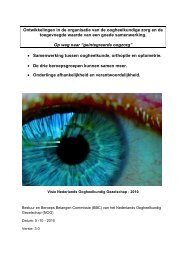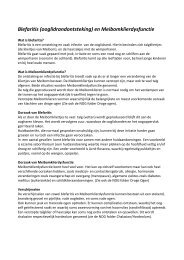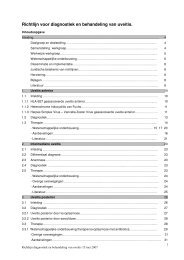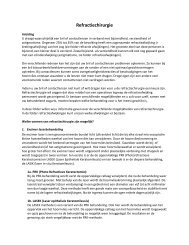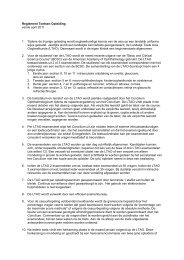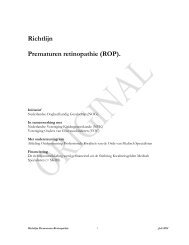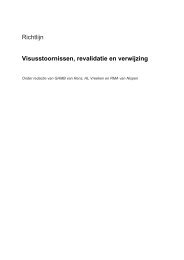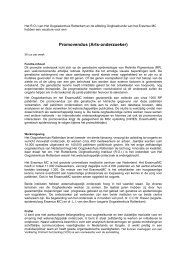terminology and guidelines for glaucoma ii - Kwaliteitskoepel
terminology and guidelines for glaucoma ii - Kwaliteitskoepel
terminology and guidelines for glaucoma ii - Kwaliteitskoepel
You also want an ePaper? Increase the reach of your titles
YUMPU automatically turns print PDFs into web optimized ePapers that Google loves.
Fig. 5<br />
A) Cirumlinear vessel,<br />
B) Bared circumlinear<br />
vessel<br />
ground. The initial abnormality in <strong>glaucoma</strong> may be either diffuse thinning or localized defects. Since the prevalence<br />
of true NFL defects is < 3% in the normal population, their presence is very likely to be pathological 13-18 .<br />
1.3.2.a - Optic disc size (vertical disc diameter)<br />
The thickness of the rim <strong>and</strong>, conversely, the size of the cup varies physiologically with the overall size of the disc 19 .<br />
The size of optic discs varies greatly in the population.<br />
Disc size is related to refractive error, being usually smaller in hyperopes than in myopes. Discs in highly myopic eyes<br />
above 7 diopters are harder to interpret.<br />
The vertical diameter of the optic disc can be measured at the slit lamp using a contact or a condensing lens. The slit<br />
beam should be coaxial with the observation axis; a narrow beam is used to measure the disc height using the white<br />
scleral ring as a reference l<strong>and</strong>mark. The magnification corrections needed vary with the optical dimensions of the<br />
eye <strong>and</strong> with the lens used <strong>for</strong> measurement. The measured or estimated ONH size should be written in the chart.<br />
Magnification correction factors<br />
Type of lens Lim CS et al 20 Manufacturer’s data<br />
Volk 60 D 0.88 0.92<br />
78 D 1.11 1.15<br />
90 D 1.33 1.39<br />
Nikon 60 D 1.03 1.02<br />
90 D 1.63 1.54<br />
Haag-Streit Goldmann - 1.14<br />
1.3.2.b - Cup/disc ratio (CDR)<br />
The decimal value obtained by dividing the cup diameter with the disc diameter. The closer the value is to 1, the<br />
worse the damage. The vertical cup/disc ratio is a better measure of deviation from normal than the horizontal ratio,<br />
because early neuroretinal rim loss occurs preferentially at the upper <strong>and</strong> lower poles of the disc 21 .<br />
A difference in cup/disc ratio between eyes with equal overall optic disc size is suggestive of tissue loss <strong>and</strong> there<strong>for</strong>e is<br />
highly suspicious of acquired damage. Expressing the size of a cup as a cup/disc ratio (C/D or CDR) is of limited value<br />
unless the actual size of the disc is known. A CDR > 0.65 is found in less than 5% of the normal population (Fig. 2a).<br />
Ch. 1 - 19 EGS



